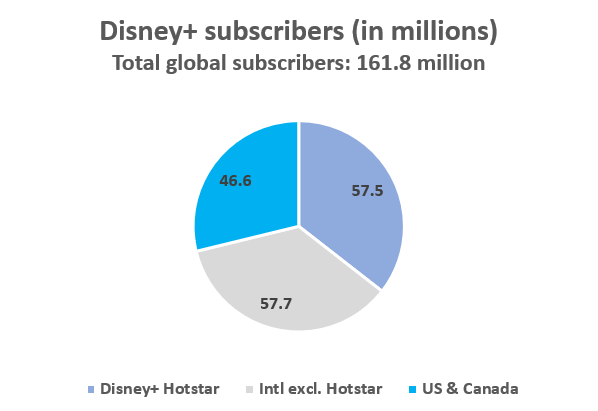Disney’s new content strategy: growing ‘quality’ subscribers

Disney CEO Bob Iger signalled to investors that the entertainment giant would be shifting its focus from purely chasing a growth in streaming subscriber numbers to trying to grow “quality” subs that are less sensitive to pricing adjustments.
The strategy comes as Disney+ reported its first-ever loss of subscribers in Q1 2023. The top-line loss of 2.4 million subscribers (-1%) was led entirely by a 6% decline in Disney+’s India division, Hotstar, which likely suffered losses in part because of its loss of streaming rights to India’s Premier League cricket. Hotstar subscriptions, which now total 57.5 million, comprise about 36% of global Disney+ subscriptions.

Subscriber numbers have in recent years become the primary measurement for investors into the health of major streaming companies. However, Disney, like Netflix, is moving away from reporting quarterly subscriber figures “in order to move beyond an emphasis on short-term quarterly metrics,” Iger said in the company’s earnings call.
“We were, as a company, in a global arms race for subscribers,” Iger reflected. “And in our zeal to go after subscribers, I think we might have gotten a bit too aggressive in terms of our promotion, and we are going to take a look at that.”
Iger, who returned to his post as Disney CEO in November following the controversy-ridden tenure of Bob Chapek, has attempted to steady what once appeared to be an uneasy ship. Disney has in recent years become embroiled in broader political issues, including its support (or lack thereof) for its diverse global staff. Since retaking the reins, Iger has also overseen the launch of Disney+’s cheaper with ads tier and mandated employees return to the office four days a week, beginning in March.
‘Aggressively chasing subs wasn’t absolutely necessary’
The company’s executives have apparently taken lessons from the fact that Disney+’s recent price increase has not resulted in a loss of subscribers outside of India.
“That tells us something,” said Iger. “It may also tell us that the promotion to chase subs that we’ve been fairly aggressive at globally, wasn’t absolutely necessary.”
Though growing subscribers will remain a priority for Disney, the company will now look to grow “quality subs that are loyal and where we actually have an ability to continue to price effectively to those subs.”
Iger, who drove Disney’s effort to greatly expand its IP catalogue through acquisitions of Marvel (2009), Lucasfilm (2012), and 21st Century Fox (2019), wants to lean more heavily on core franchises like the Marvel Cinematic Universe (MCU), Star Wars, and Avatar.
Critics of Disney’s content argue that the quality has dipped in recent years. Average scores of MCU films have dipped from Phase 3, which concluded with Avengers: Endgame, to Phase 4, according to IMDb (Phase 3’s average score: 7.6; Phase 4’s average score: 7.0). Meanwhile, the Star Wars sequel trilogy and subsequent litany of spin-offs have received mixed reviews, with Andor being a critical bright spot in an era of otherwise middling reception.
At least for now, that hasn’t stopped the various franchises from raking in revenue. Disney made $4.9bn in box office revenue last year across 16 films, and the brands are performing just as well on streaming. Citing Nielsen data, Iger noted to investors that 10 of the top 15 movies streamed in the US were Disney’s, including older films with long-tail viewership like Moana (2016), Zootopia (2016), and Frozen (2013).
Extraordinary expenses
Costs for producing so many major, high-budget films have increased over time—Black Panther: Wakanda Forever cost a quarter of a billion dollars to produce, without accounting for its marketing budget, as just one example. In the last quarter alone, Disney reported expenditures of $279m in its Media and Entertainment Distribution division, a 39% increase year-over-year.
Though Disney has a strong flywheel effect on repackaging its film IPs as merchandise and parks experiences, the company is looking to be more judicious with its spending going forward. Like other major tech and entertainment companies like Meta and Spotify, Iger stressed the need for greater efficiency of resources amid broader economic uncertainty.
“We have to be better at curating the Disney and the Pixar and the Marvel and the Star Wars of it all […] and of course reduce costs on everything that we make because, while we’re extremely proud of what’s on the screen, it’s gotten to a point where it’s extraordinarily expensive.”
Cutting costs is an immediate priority for Disney, which communicated it would layoff around 7,000 employees as it targets $5.5bn in savings across the company. That includes $2.5bn in reductions to non-content costs.
The decrease in spending is necessitated in part because of the ballooning costs of Disney+, which Iger insists will hit profitability by the end of fiscal year 2024. Calling it a “transition period” between Disney’s future focussed primarily on streaming, Iger nonetheless reassured that Disney does not currently plan to abandon traditional, linear platforms that still provide a benefit to the company.
“The streaming business, which I believe is the future and has been growing, is not delivering the kind of profitability or bottom-line results that the linear business delivered for us over a few decades.
“Since my return, I have drilled down into every facet of the streaming business to determine how to achieve both profitability and growth. And so, with that goal in mind, we will focus even more on our core brands and franchises, which have consistently delivered higher returns.”




